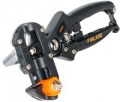Handle material
The material from which the additional overlays for the tool handle are made. Most often, this material differs from the material of the handle itself (see above), but there are exceptions — for example, additional plastic lining on the plastic handle. Anyway, the most popular types of materials are as follows:
— Rubber. Convenient, practical and inexpensive, and therefore — an extremely popular material. Secure to hold and at the same time relatively soft, making it great for both plastic and metal handles: rubber grips do not slip in the hand, do not cool the skin in cool weather and provide additional comfort due to the softness. The disadvantages of rubber include poor scratch resistance and a slightly higher cost than another popular option — plastic. However, in general, these shortcomings cannot be called critical.
— Plastic. Another fairly popular material, widely used primarily with steel and aluminium handles. Plastic provides a secure hold, it does not slip in the hand like metal; in addition, such pads are not afraid of moisture and can also play the role of additional protection against corrosion. However plastic is harder than rubber and somewhat less reliable and durable; On the other hand, it also costs much less.
— Wood. A material rarely used, mainly with metal (steel) handles. The tree is very attractive in terms of convenience: it is pleasant to the touch, does not cool the hands and almost does not slip. On the other hand, su...ch pads are less reliable than rubber or plastic ones, they do not tolerate moisture (the material can swell and warp) and contact with sharp objects (slivers can form, threatening splinters). So it makes sense to specifically look for wooden handles, first of all, if you are a principled adherent of the classics.
— Cork. The cork does not slip in the hands and perfectly absorbs moisture, thanks to which it is securely held in the hands. In addition, this material is soft and elastic, which gives additional convenience and comfort. At the same time, compared to the same rubber, cork is less durable: it is relatively easily damaged and, without special care, quickly absorbs dirt, which can cause it to lose its “presentation” and then its working properties. As a result, cork overlays are extremely rare — in some models of garden tools.

